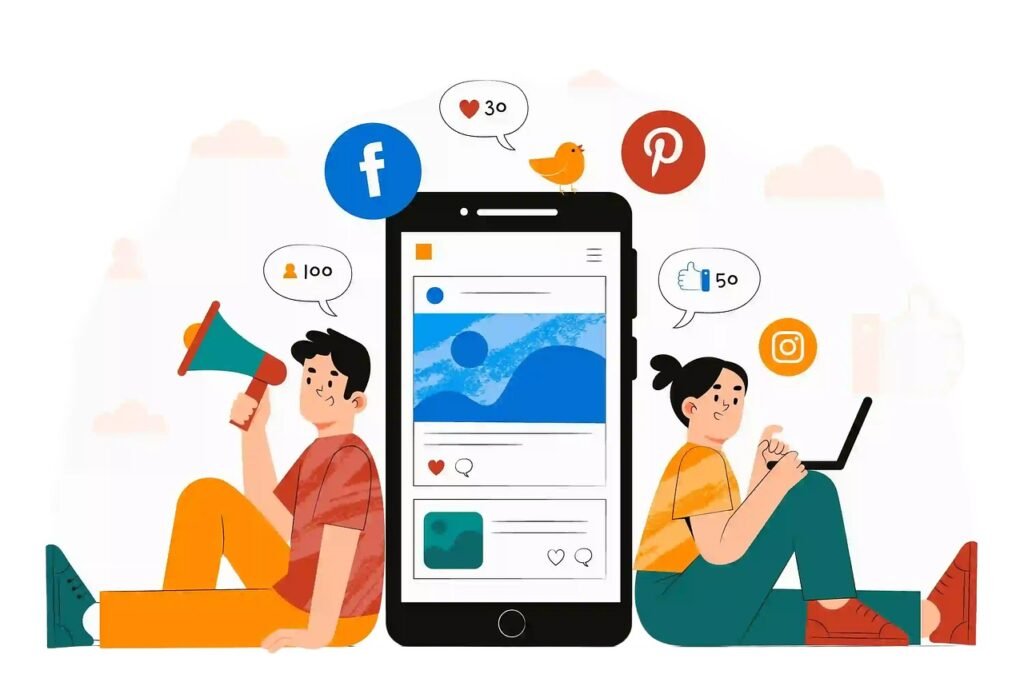- 1. Why is Video Marketing Important in 2024?
- 2. How Does Custom Content Influence Consumer Behavior?
- 3. Why Should Businesses Invest in Content Marketing?
- 4. What is the ROI of Email Marketing?
- 5. Why is Brand Awareness a Top Goal for Marketers?
- 6. How Effective are Landing Pages for Lead Generation?
- 7. Why Do Marketers Consider Their Content a Business Asset?
- 8. How Can Personalized Email Campaigns Impact Revenue?
- 9. How Does Facebook Play a Role in Professional Purposes?
- 10. How Do Social Media Platforms Influence Purchase Decisions?
- 11. How Does Customized Content Affect Consumer Perception?
- 12. Why is Email Marketing Considered the Most Effective Channel by Large Companies?
- 13. How Does Relevant Content Creation Impact SEO?
- 14. Why Should Businesses Consider Blogging?
- 15. How is Influencer Marketing Evolving in 2024?
- 16. How Many Content Pieces Do Buyers Engage With Before Contacting Sales?
- 17. Why Should Businesses Focus on Mobile Optimization?
- 18. How is Social Media Advertising Evolving?
- 19. Why is Social Media Important for Marketing Strategies?
- 20. How Does Mobile Ad Spend Compare to Overall Digital Ad Spend?
- 21. How Does Video Content Influence Consumer Purchases?
- 22. Why is Visual Content More Likely to be Shared on Social Media?
- 23. Why is Video a Popular Marketing Tool?
- 24. How Does Interactive Content Compare to Passive Content in Terms of Conversions?
- 25. Why is LinkedIn a Key Marketing Channel for B2B Marketers?
- 26. How Does SEO and Organic Presence Impact Inbound Marketing?
- 27. Why is Social Media Marketing Considered Effective?
- 28. What is the Future of Live Video in Digital Marketing?
- 29. How Does High-Quality Content Affect SEO Strategy?
- 30. How Does Marketing Automation Impact Productivity?
- We got all the latest Marketing Stats here:
As we move into 2024, the marketing landscape continues to evolve at a rapid pace. Staying ahead of the curve means leveraging data-driven insights to craft strategies that resonate with your audience and drive results. In this article, we’ll explore key marketing statistics that will help you shape and refine your marketing strategy for 2024. Each section answers a commonly asked question, providing not just the data but also actionable insights to help you succeed. Let’s dive in and see what the numbers have to say about the future of marketing.
1. Why is Video Marketing Important in 2024?

The Growing Significance of Video Marketing
92% of marketers believe that video is an important part of their marketing strategy. Video content has become a cornerstone of digital marketing due to its ability to engage audiences and convey messages effectively. With platforms like YouTube, TikTok, and Instagram prioritizing video content, it’s clear that consumers are craving more visual and dynamic forms of communication.
Actionable Insights for Video Marketing
To leverage video marketing in 2024, start by creating high-quality, engaging content that speaks directly to your target audience. Consider incorporating various types of video, such as explainer videos, product demos, customer testimonials, and live streams. Ensure your videos are optimized for mobile viewing, as a significant portion of your audience will likely be watching on their smartphones. Additionally, focus on storytelling to make your videos more relatable and memorable.
2. How Does Custom Content Influence Consumer Behavior?
The Power of Custom Content
61% of consumers say they are more likely to purchase from a brand that creates custom content. Personalized content helps build a connection with your audience by addressing their specific needs and interests. It shows that your brand understands and values its customers, which can significantly influence their purchasing decisions.
Actionable Insights for Custom Content
To create effective custom content, start by understanding your audience’s preferences and pain points. Use data and analytics to gain insights into what your customers are looking for, and tailor your content accordingly. This could include blog posts, social media updates, emails, and more. Personalization tools and techniques, such as dynamic content and segmentation, can help deliver more relevant and engaging content to each customer.
3. Why Should Businesses Invest in Content Marketing?
The Value of Content Marketing Investment
70% of marketers are actively investing in content marketing. Content marketing remains a powerful tool for building brand awareness, generating leads, and nurturing customer relationships. By providing valuable and relevant content, businesses can attract and retain a clearly defined audience, ultimately driving profitable customer actions.
Actionable Insights for Content Marketing
To maximize the benefits of content marketing, develop a comprehensive content strategy that aligns with your business goals. Focus on creating high-quality content that addresses your audience’s needs and solves their problems. Diversify your content formats to include blogs, videos, infographics, podcasts, and more. Consistently monitor and analyze your content performance to refine your strategy and ensure you’re delivering the most value to your audience.
4. What is the ROI of Email Marketing?
The High ROI of Email Marketing
Email marketing has an average ROI of $42 for every $1 spent. This impressive return on investment makes email one of the most cost-effective marketing channels available. Email marketing allows businesses to reach their audience directly, delivering personalized and relevant messages that drive engagement and conversions.
Actionable Insights for Email Marketing
To achieve a high ROI from email marketing, focus on building a quality email list. Use lead magnets, such as eBooks, webinars, or exclusive discounts, to attract subscribers. Segment your email list to send targeted campaigns based on customer behavior and preferences. Craft compelling subject lines and email content that encourage opens and clicks. Finally, regularly test and optimize your email campaigns to improve performance and achieve better results.
5. Why is Brand Awareness a Top Goal for Marketers?
The Importance of Brand Awareness
89% of marketers say that brand awareness is their top goal. Brand awareness is crucial because it helps consumers recognize and remember your brand, making them more likely to choose your products or services over competitors. A strong brand presence also builds trust and credibility, which are essential for long-term success.
Actionable Insights for Building Brand Awareness
To build brand awareness, focus on creating a consistent and recognizable brand identity. This includes your logo, colors, fonts, and messaging. Utilize various marketing channels, such as social media, content marketing, and advertising, to increase your brand’s visibility. Engage with your audience through interactive content and community-building activities. Collaborating with influencers and leveraging user-generated content can also amplify your brand’s reach.
6. How Effective are Landing Pages for Lead Generation?
The Effectiveness of Landing Pages
68% of B2B businesses use landing pages to garner new sales leads for future conversion. Landing pages are highly effective for capturing leads because they are designed with a single goal in mind – to convert visitors into prospects by collecting their contact information.
Actionable Insights for Creating Effective Landing Pages
To create effective landing pages, focus on a clear and compelling call to action (CTA). Your landing page should have a clean and simple design, with minimal distractions. Use persuasive headlines and concise, benefit-oriented copy to communicate the value of your offer. Include visual elements, such as images or videos, to enhance engagement. Finally, ensure your landing page is mobile-friendly and loads quickly to provide a smooth user experience.
7. Why Do Marketers Consider Their Content a Business Asset?
Viewing Content as a Business Asset
81% of marketers view their content as a business asset. Treating content as an asset means recognizing its long-term value in driving traffic, generating leads, and building relationships with customers. Quality content can continue to attract and engage audiences long after it is published.
Actionable Insights for Maximizing Content Value
To maximize the value of your content, focus on creating evergreen content that remains relevant over time. This could include how-to guides, industry insights, and best practices. Regularly update and repurpose your content to keep it fresh and extend its lifespan. Additionally, leverage SEO best practices to ensure your content ranks well in search engine results, driving continuous organic traffic to your site.
8. How Can Personalized Email Campaigns Impact Revenue?
The Revenue Impact of Personalized Email Campaigns
Personalized email campaigns can increase revenue by 760%. Personalization enhances the relevance and effectiveness of your emails, making recipients more likely to engage and convert. By tailoring your messages to individual preferences and behaviors, you can deliver a more personalized and impactful experience.
Actionable Insights for Personalizing Email Campaigns
To personalize your email campaigns, start by collecting and analyzing customer data. Use this data to segment your email list and create targeted campaigns for different customer groups. Personalize your email content by addressing recipients by name and tailoring your messages based on their interests and past interactions. Implement dynamic content to deliver real-time personalization within your emails. Continuously test and refine your personalization strategies to optimize results.
9. How Does Facebook Play a Role in Professional Purposes?
The Professional Use of Facebook
74% of people say they use Facebook for professional purposes. Facebook is not just a social platform for personal connections; it also serves as a valuable tool for professional networking, brand promotion, and business communication. Many businesses use Facebook to connect with their audience, share industry news, and promote their products or services.
Actionable Insights for Leveraging Facebook Professionally
To leverage Facebook for professional purposes, create a comprehensive Facebook marketing strategy. Start by setting up a professional and engaging business page. Regularly post relevant content, such as industry news, blog articles, and company updates, to keep your audience informed and engaged. Use Facebook Ads to target specific professional groups and promote your products or services. Engage with your audience through comments, messages, and live events to build relationships and foster community.
10. How Do Social Media Platforms Influence Purchase Decisions?

The Influence of Social Media on Purchases
86% of women will look at social media before deciding to make a purchase. Social media platforms play a significant role in shaping consumer purchase decisions. They provide a space for consumers to discover new products, read reviews, and seek recommendations from their network.
Actionable Insights for Influencing Purchase Decisions on Social Media
To influence purchase decisions on social media, focus on building a strong and authentic presence. Share high-quality, visually appealing content that showcases your products or services. Encourage satisfied customers to share their experiences and tag your brand. Utilize influencer marketing to reach a broader audience and build credibility. Additionally, engage with your audience by responding to comments and messages, and participate in relevant conversations to establish your brand as a trusted authority.
11. How Does Customized Content Affect Consumer Perception?
The Positive Impact of Customized Content
82% of consumers feel more positive about a brand after reading customized content. Customized content helps to build a deeper connection with your audience by addressing their unique needs and interests. This personalized approach makes consumers feel valued and understood, which can significantly improve their perception of your brand.
Actionable Insights for Creating Customized Content
To create customized content, start by understanding your audience’s preferences and behaviors. Use data and analytics to segment your audience and create tailored content for each segment. Personalize your blog posts, social media updates, and email campaigns to address specific interests and pain points. Incorporate user-generated content and customer testimonials to add authenticity and relevance. By consistently delivering customized content, you can enhance your brand’s reputation and foster stronger customer relationships.
12. Why is Email Marketing Considered the Most Effective Channel by Large Companies?
The Effectiveness of Email Marketing
79% of marketers in large companies rate email as the most effective marketing channel. Email marketing’s effectiveness lies in its ability to deliver targeted, personalized messages directly to consumers. It offers a high ROI and allows businesses to nurture leads and build long-term relationships with customers.
Actionable Insights for Maximizing Email Marketing Effectiveness
To maximize the effectiveness of your email marketing, focus on building a quality email list with engaged subscribers. Use lead magnets and opt-in forms to attract subscribers who are genuinely interested in your content. Segment your email list based on customer behavior and preferences to send targeted campaigns. Craft compelling subject lines and email content that encourage opens and clicks. Use A/B testing to optimize your campaigns and continuously improve performance.
13. How Does Relevant Content Creation Impact SEO?
The SEO Benefits of Relevant Content
72% of marketers say relevant content creation was the most effective SEO tactic. Creating relevant content that addresses the needs and interests of your audience can significantly improve your search engine rankings. High-quality, relevant content attracts more visitors, keeps them engaged, and encourages them to spend more time on your site, all of which are positive signals for search engines.
Actionable Insights for Creating SEO-Friendly Content
To create SEO-friendly content, start by conducting keyword research to identify the terms and phrases your audience is searching for. Incorporate these keywords naturally into your content, including in your headlines, subheadings, and throughout the body text. Focus on creating high-quality, informative content that provides value to your audience. Use internal and external links to enhance your content’s credibility and improve its SEO performance. Regularly update and repurpose your content to keep it fresh and relevant.
14. Why Should Businesses Consider Blogging?
The Benefits of Blogging
Companies that blog get 55% more website visitors than those that don’t. Blogging is a powerful tool for driving traffic to your website, building brand awareness, and establishing your authority in your industry. Regularly publishing blog posts can help you attract new visitors, engage your audience, and improve your search engine rankings.
Actionable Insights for Effective Blogging
To create an effective blog, start by identifying the topics that are most relevant to your audience. Use keyword research to find the questions and issues your audience is searching for, and create blog posts that address these topics. Focus on providing valuable, actionable insights that help your readers solve problems or achieve their goals. Promote your blog posts through social media, email marketing, and other channels to reach a wider audience. Regularly analyze your blog’s performance and use this data to refine your content strategy.
15. How is Influencer Marketing Evolving in 2024?
The Growing Importance of Influencer Marketing
65% of marketers plan to increase their influencer marketing budgets in 2024. Influencer marketing continues to be a powerful strategy for reaching and engaging with audiences. By partnering with influencers, businesses can leverage their reach and credibility to promote their products or services to a wider audience.
Actionable Insights for Influencer Marketing
To maximize the effectiveness of your influencer marketing, start by identifying the influencers who align with your brand values and target audience. Look for influencers who have a genuine connection with their followers and can authentically promote your products or services. Develop a clear strategy and set specific goals for your influencer campaigns. Provide influencers with the creative freedom to produce content that resonates with their audience while staying true to your brand message. Monitor and analyze the performance of your influencer campaigns to ensure they are driving the desired results.

16. How Many Content Pieces Do Buyers Engage With Before Contacting Sales?
The Buyer’s Journey and Content Engagement
47% of buyers viewed 3-5 pieces of content before engaging with a sales rep. This statistic underscores the importance of providing valuable content throughout the buyer’s journey. Potential customers often consume multiple pieces of content to educate themselves and build trust before making a purchase decision.
Actionable Insights for Supporting the Buyer’s Journey
To support the buyer’s journey, create a variety of content that addresses different stages of the decision-making process. Provide educational content, such as blog posts, eBooks, and webinars, to attract and inform potential customers. Offer case studies, testimonials, and product demos to help prospects evaluate your offerings. Ensure that your content is easily accessible and shareable, allowing potential customers to find and engage with it at their own pace. Use marketing automation to nurture leads and guide them through the buyer’s journey with targeted content.
17. Why Should Businesses Focus on Mobile Optimization?
The Prevalence of Mobile Device Usage
80% of internet users own a smartphone. With the majority of internet users accessing the web via mobile devices, optimizing your digital presence for mobile is crucial. Mobile optimization ensures that your website and content provide a seamless and user-friendly experience on smartphones and tablets.
Actionable Insights for Mobile Optimization
To optimize for mobile, start by ensuring that your website is responsive and adapts to different screen sizes. Use mobile-friendly design principles, such as larger fonts, touch-friendly buttons, and simplified navigation. Optimize your website’s loading speed, as slow-loading pages can frustrate mobile users and drive them away. Test your website on various devices and browsers to ensure it performs well across the board. Additionally, consider creating mobile-specific content, such as short videos and social media posts, to engage your mobile audience.
18. How is Social Media Advertising Evolving?
The Growth of Social Media Advertising
Social media advertising spending is expected to reach over $200 billion in 2024. Social media platforms continue to be a key channel for digital advertising, offering businesses the opportunity to reach a vast and engaged audience. With advanced targeting options, social media advertising allows businesses to deliver personalized and relevant ads to specific segments of their audience.
Actionable Insights for Social Media Advertising
To maximize the effectiveness of your social media advertising, start by identifying the platforms that are most popular with your target audience. Develop a clear strategy and set specific goals for your campaigns. Use advanced targeting options to reach the right audience with your ads. Create visually appealing and engaging ad content that captures attention and drives action. Monitor and analyze the performance of your campaigns to identify what works and make data-driven adjustments.
19. Why is Social Media Important for Marketing Strategies?
The Importance of Social Media for Marketers
88% of marketers believe that social media is important to their marketing strategy. Social media platforms offer businesses the opportunity to connect with their audience, build brand awareness, and drive engagement. By leveraging social media, businesses can reach a broader audience and create meaningful interactions with their customers.
Actionable Insights for Social Media Marketing
To effectively leverage social media for your marketing strategy, start by identifying the platforms that are most relevant to your audience. Develop a content calendar that outlines your posting schedule and the types of content you will share. Focus on creating high-quality, engaging content that resonates with your audience. Use social media analytics to track your performance and identify opportunities for improvement. Engage with your audience by responding to comments and messages, and participating in relevant conversations.
20. How Does Mobile Ad Spend Compare to Overall Digital Ad Spend?

The Shift Towards Mobile Ad Spend
Mobile devices are expected to account for 72% of digital ad spend by the end of 2024. This shift towards mobile advertising reflects the increasing use of smartphones and tablets for internet browsing and online shopping. Businesses need to prioritize mobile ad spend to reach their audience where they are spending the most time.
Actionable Insights for Mobile Advertising
To effectively allocate your ad spend to mobile, start by creating mobile-optimized ad content. Use formats that perform well on mobile devices, such as short videos, carousel ads, and interactive ads. Leverage mobile-specific targeting options, such as location-based targeting and device-specific targeting, to reach your audience more effectively. Monitor and analyze the performance of your mobile ad campaigns to ensure they are driving the desired results. Continuously refine your mobile advertising strategy based on data and insights.
21. How Does Video Content Influence Consumer Purchases?
The Impact of Video on Purchase Decisions
64% of consumers purchase after watching branded social videos. Video content is highly engaging and can effectively convey information and emotions, making it a powerful tool for influencing purchase decisions. By showcasing your products or services through video, you can capture your audience’s attention and drive conversions.
Actionable Insights for Video Marketing
To leverage the power of video content, start by creating high-quality videos that highlight the benefits and features of your products or services. Use storytelling to make your videos more relatable and memorable. Optimize your videos for social media by creating short, attention-grabbing clips that can be easily shared. Include clear calls to action in your videos to guide viewers towards making a purchase. Monitor and analyze the performance of your videos to identify what resonates with your audience and refine your strategy accordingly.
22. Why is Visual Content More Likely to be Shared on Social Media?
The Shareability of Visual Content
Visual content is more than 40 times more likely to get shared on social media. Visual elements, such as images, infographics,
and videos, are highly engaging and can quickly capture attention. They are also easier to consume and share, making them ideal for social media platforms.
Actionable Insights for Creating Shareable Visual Content
To create shareable visual content, focus on producing high-quality and visually appealing graphics. Use bold colors, striking images, and clear typography to make your content stand out. Incorporate elements of storytelling to make your visuals more engaging and relatable. Optimize your visuals for different social media platforms by adjusting the size and format as needed. Encourage your audience to share your content by including social sharing buttons and clear calls to action.
23. Why is Video a Popular Marketing Tool?
The Popularity of Video Marketing
81% of businesses use video as a marketing tool. Video marketing is popular because it is highly effective in capturing attention, conveying information, and driving engagement. Videos can be used for various purposes, including product demonstrations, customer testimonials, brand storytelling, and educational content.
Actionable Insights for Video Marketing
To effectively use video as a marketing tool, start by identifying the types of videos that resonate most with your audience. Create a content calendar that outlines your video production schedule and topics. Invest in quality equipment and editing software to produce professional-looking videos. Optimize your videos for search engines by including relevant keywords in the title, description, and tags. Promote your videos through social media, email marketing, and other channels to reach a wider audience. Monitor and analyze the performance of your videos to identify what works and make data-driven adjustments.
24. How Does Interactive Content Compare to Passive Content in Terms of Conversions?
The Effectiveness of Interactive Content
Interactive content generates 2x more conversions than passive content. Interactive content, such as quizzes, polls, and interactive infographics, engages users by requiring their active participation. This increased engagement can lead to higher conversion rates as users are more invested in the content.
Actionable Insights for Creating Interactive Content
To create effective interactive content, start by identifying the types of interactions that resonate most with your audience. Use tools and platforms that allow you to easily create and integrate interactive elements into your content. Ensure that your interactive content is relevant and valuable to your audience, providing insights or entertainment that encourages participation. Promote your interactive content through social media, email marketing, and other channels to reach a wider audience. Monitor and analyze the performance of your interactive content to identify what works and make data-driven adjustments.
25. Why is LinkedIn a Key Marketing Channel for B2B Marketers?
The Role of LinkedIn in B2B Marketing
73% of B2B marketers use LinkedIn as a marketing channel. LinkedIn is a valuable platform for B2B marketing because it is specifically designed for professional networking and business-related content. It offers a unique opportunity to connect with industry professionals, share thought leadership, and generate leads.
Actionable Insights for LinkedIn Marketing
To effectively use LinkedIn for B2B marketing, start by creating a professional and engaging company page. Share relevant and valuable content, such as industry news, blog articles, and case studies, to establish your brand as a thought leader. Use LinkedIn Ads to target specific professional groups and promote your products or services. Engage with your audience by participating in relevant groups and conversations, and by responding to comments and messages. Monitor and analyze the performance of your LinkedIn marketing efforts to identify what works and make data-driven adjustments.
26. How Does SEO and Organic Presence Impact Inbound Marketing?

The Importance of SEO in Inbound Marketing
69% of marketers say improving SEO and growing their organic presence is their top inbound marketing priority. SEO is crucial for inbound marketing because it helps attract organic traffic to your website. By optimizing your site and content for search engines, you can improve your visibility and attract more qualified leads.
Actionable Insights for SEO and Organic Presence
To improve your SEO and organic presence, start by conducting keyword research to identify the terms and phrases your audience is searching for. Optimize your website and content for these keywords, including in your headlines, subheadings, and throughout the body text. Focus on creating high-quality, informative content that provides value to your audience. Use internal and external links to enhance your content’s credibility and improve its SEO performance. Regularly monitor and analyze your SEO performance to identify opportunities for improvement and make data-driven adjustments.
27. Why is Social Media Marketing Considered Effective?
The Effectiveness of Social Media Marketing
75% of marketers say their social media marketing efforts have been effective. Social media marketing is effective because it allows businesses to connect with their audience, build brand awareness, and drive engagement. By leveraging social media platforms, businesses can reach a broader audience and create meaningful interactions with their customers.
Actionable Insights for Social Media Marketing
To effectively leverage social media for your marketing strategy, start by identifying the platforms that are most relevant to your audience. Develop a content calendar that outlines your posting schedule and the types of content you will share. Focus on creating high-quality, engaging content that resonates with your audience. Use social media analytics to track your performance and identify opportunities for improvement. Engage with your audience by responding to comments and messages, and participating in relevant conversations.
28. What is the Future of Live Video in Digital Marketing?
The Growth of Live Video
Live video is expected to account for 82% of all internet traffic by 2024. Live video is becoming increasingly popular because it offers a real-time, interactive experience that can engage audiences in a way that pre-recorded content cannot. It allows businesses to connect with their audience, answer questions, and build relationships in real-time.
Actionable Insights for Live Video Marketing
To leverage the power of live video, start by identifying the types of live content that resonate most with your audience. Consider hosting live events, Q&A sessions, product demonstrations, or behind-the-scenes tours. Promote your live videos in advance to build anticipation and attract viewers. Engage with your audience during the live broadcast by responding to comments and questions. After the live event, repurpose the video content by sharing it on your website, social media, and other channels to reach a wider audience.
29. How Does High-Quality Content Affect SEO Strategy?
The Role of High-Quality Content in SEO
78% of marketers say that their most effective SEO strategy involves creating high-quality content. High-quality content is essential for SEO because it attracts and engages visitors, encourages them to spend more time on your site, and signals to search engines that your site is valuable and relevant.
Actionable Insights for Creating High-Quality Content
To create high-quality content, start by understanding your audience’s needs and preferences. Conduct keyword research to identify the terms and phrases your audience is searching for, and create content that addresses these topics. Focus on providing valuable, informative, and engaging content that solves your audience’s problems or answers their questions. Use visual elements, such as images, videos, and infographics, to enhance your content and make it more engaging. Regularly update and repurpose your content to keep it fresh and relevant. Monitor and analyze the performance of your content to identify what works and make data-driven adjustments.
30. How Does Marketing Automation Impact Productivity?
The Productivity Benefits of Marketing Automation
83% of marketers agree that using automation in their marketing efforts increases productivity. Marketing automation streamlines and automates repetitive tasks, such as email campaigns, social media posts, and lead nurturing, allowing marketers to focus on more strategic activities.
Actionable Insights for Implementing Marketing Automation
To implement marketing automation effectively, start by identifying the tasks and processes that can be automated. Choose a marketing automation platform that aligns with your needs and integrates with your existing tools. Develop a clear strategy and set specific goals for your automation efforts. Use automation to segment your audience and deliver personalized content at scale. Regularly monitor and analyze the performance of your automated campaigns to ensure they are driving the desired results. Continuously refine your automation strategy based on data and insights to maximize productivity and effectiveness.
We got all the latest Marketing Stats here:
Read Next
- How Twitter Affects SEO for Travel Businesses
- Instagram SEO Strategies for Travel Influencers
- Pinterest SEO for Travel Blogs and Businesses
- Social Media Signals and SEO for Travel Websites
- How to Use Analytics to Understand Travel Seasonality






















Comments are closed.